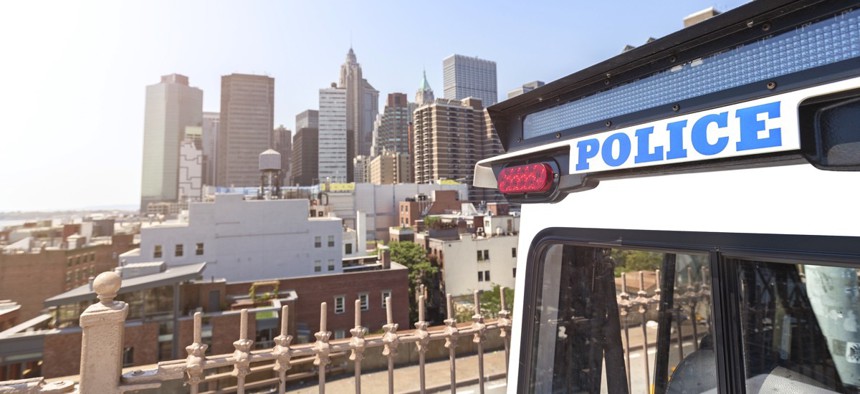Another Blow to the Overarching ‘Ferguson Effect’ Theory

New York City police Maciej Bledowski / Shutterstock.com
A new University of Colorado-Boulder study found urban crime remains low.
Although some elected officials, members of law enforcement and others have said there’s a connection between the public’s reaction to the 2014 officer-involved shooting death of Michael Brown in Ferguson, Missouri, and an apparent spike in crime around the nation, a new University of Colorado Boulder study shows that there is no definitive link.
In the 81 major cities the university recently analyzed, there’s no widespread surge in violent or property crimes resulting from the high-profile shooting, though instances of robbery and, occasionally, homicide increased.
The study tested the claim by some members of law enforcement, legal, political and media circles that social media negativity toward police after Brown’s death has fueled crime—the so-called “Ferguson Effect.”
“The one crime that is showing signs of increasing is robbery,” said Scott Decker, Arizona State University criminology professor and study co-author, in Thursday’s announcement. “Robbery drives fear of crime among the general population and is among the most feared crimes, so that’s concerning.”
Proponents of the Ferguson Effect hold that police, wary of public criticism and potential litigation, won’t always intervene to stop crimes when they should—creating a culture of mistrust.
FBI Director James Comey and Drug Enforcement Administration Administrator Chuck Rosenberg voiced this concern late last year.
But, if that’s the case, criminals clearly aren’t taking advantage because crime rates remain low, according to the study.
The few cities where homicides rose had some commonalities.
“These are cities with historically high levels of violence, high concentration of socioeconomic disadvantages, more police per capita and a demographic makeup that differs from cities where homicide rates remained flat,” David Pyrooz, assistant sociology professor and study lead, said in the University of Colorado’s announcement.
An analysis of 2015 crime performed by the Brennan Center for Justice had similar findings.
Once all 2015 crime data is in, expect to see a 5.5 decline since 2014, according to the Brennan Center report.
Among the 30 largest cities, the Brennan Center projects a 14.6 percent increase in the murder rate spurred primarily by Baltimore and the District of Columbia for many of the systemic reasons cited in the UCB study. Because murder rates are on the low side, about where they were in 2012, small numerical increases mean large percentage change:
“The average person in a large urban area is safer walking on the street today than he or she would have been at almost any time in the past 30 years. Although headlines suggesting a coming crime wave make good copy, a look at the available data shows there is no evidence to support this claim.”
General consensus is crime remains at a two-decade low, though the U.S. Department of Justice still has its work cut out for it in cities facing low incomes, high levels of poverty and unemployment and shrinking populations.
As the Ferguson Effect is discounted by crime data, some police departments are shifting their rhetoric. In Chicago, some in law enforcement are blaming a January rise in fatal shootings on the “ACLU Effect.”
The Chicago Police Department agreed to allow the American Civil Liberties Union of Illinois to monitor police stops with more detailed reporting forms than its usual contact cards. About 50 murders occurred in the nation’s third-largest city in January while officers completed 79 percent fewer contact cards, the Chicago Sun-Times reported.
“We are conducting training on the new investigative stop law and reporting requirements and that is taking place three shifts per day,” Chicago’s interim police superintendent, John Escalante, told the Sun-Times.
The ACLU of Illinois isn’t buying officers’ complaints about the decline in stops, according to Police Practices Project Director Karen Sheley. According to Time magazine:
The ACLU of Illinois rejects any suggestion of a so-called “ACLU effect” to explain the recent spike in gun violence on Chicago’s streets. There is no discernible link between the rate of invasive street stops and searches by police and the level of violence on those streets. Indeed, when such stops dramatically decreased in other cities, like New York City, we saw no such rise in crime. There simply is not any evidence of this effect. The reality is that “Terry” stops, street stops that often include a frisk of the person detained, are not a very effective tool for policing, since they involve stopping a large number of people to discover little criminal activity or contraband. We issued a report in March of 2015 revealing that during the summer of 2014, Chicago police stopped more than 250,000 persons (and presumably frisked a very high percentage) without arresting or issuing a ticket to one of these individuals.
Sheley went on to say the stops are often “intrusive and very embarrassing.”
Dave Nyczepir is a News Editor at Government Executive's Route Fifty.
NEXT STORY: Maryland Bill Aims to Shield the ‘Right to Yelp’ for Consumers






